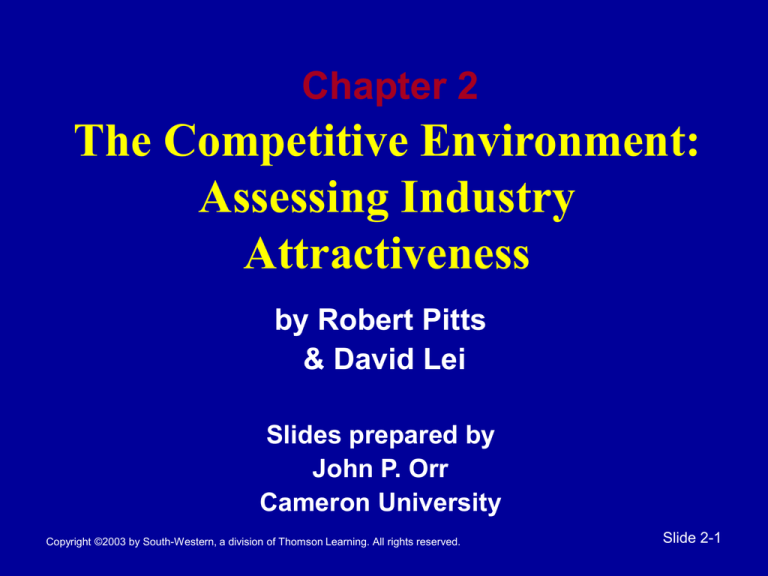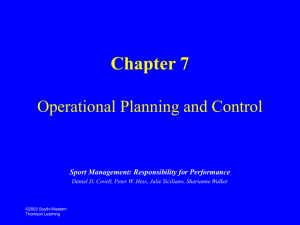
Chapter 2
The Competitive Environment:
Assessing Industry
Attractiveness
by Robert Pitts
& David Lei
Slides prepared by
John P. Orr
Cameron University
Copyright ©2003 by South-Western, a division of Thomson Learning. All rights reserved.
Slide 2-1
What you will learn…
Slide 1 of 2
• The nature of the general environment,
also known as the macroenvironment
• Macroenvironment influences over
competition between firms and
organizations
• The nature of the industry environment,
also known as the competitive
environment
Copyright ©2003 by South-Western, a division of Thomson Learning. All rights reserved.
Slide 2-2
What you will learn…
Slide 2 of 2
• The Five Forces that make up the
industry environment:
–
–
–
–
–
Barriers to entry
Supplier power
Buyer power
Availability of substitutes
Rivalry among firms
• The concept of Strategic Groups
• Techniques companies use to monitor
changes in the environment
Copyright ©2003 by South-Western, a division of Thomson Learning. All rights reserved.
Slide 2-3
Personal Computer: Key Parts
• Microprocessor
• Hard drive
• CD-ROM or DVD
drive
• Printed circuit boards
• Keyboard
• Monitor
Copyright ©2003 by South-Western, a division of Thomson Learning. All rights reserved.
Slide 2-4
The Concept of Environment
• Environment
All external forces, factors, or conditions
that exert some degree of impact on the
strategies, decisions, and actions taken by
the firm
• Macroenvironment
• General environment
The broad collection of forces or conditions
that affect the firm or organization in every
industry
Copyright ©2003 by South-Western, a division of Thomson Learning. All rights reserved.
Slide 2-5
Macroenvironment Influences
Demographic
Political
Global
Social/
Cultural
Technological
Copyright ©2003 by South-Western, a division of Thomson Learning. All rights reserved.
Slide 2-6
The Competitive Environment
• Industry Attractiveness
The potential for profitability
in a given industry
• Industry Structure
The interrelationship among the factors in a
firm’s competitive or industry
environment.
Copyright ©2003 by South-Western, a division of Thomson Learning. All rights reserved.
Slide 2-7
Ex. 2-1. Porter’s Five Forces
Model of Industry Attractiveness
Potential
Entrants
Threat of new entrants
Suppliers
Bargaining
power of
suppliers
Industry
competitors
Rivalry
among
existing firms
Bargaining
power of
buyers
Buyers
Threat of substitute products or services
Substitutes
Copyright ©2003 by South-Western, a division of Thomson Learning. All rights reserved.
Slide 2-8
Barriers to Entry
•
•
•
•
•
•
•
•
•
•
•
Economies of scale
Proprietary product differences
Brand identity
Switching costs
Capital requirements
Access to distribution channels
Absolute cost advantages
Proprietary learning curve
Access to necessary inputs
Government policy
Expected retaliation
Copyright ©2003 by South-Western, a division of Thomson Learning. All rights reserved.
Slide 2-9
Determinants of Rivalry
•
•
•
•
•
•
•
•
•
•
Industry growth
Fixed (or storage) cost / Value added
Intermittent overcapacity
Product differences
Brand identity
Switching costs
Concentration and balance
Informational complexity
Diversity of competitors
Exit barriers
Copyright ©2003 by South-Western, a division of Thomson Learning. All rights reserved.
Slide 2-10
Determinants of Substitution Threat
• Relative price/ Performance of
substitutes
• Switching costs
• Buyer propensity to substitute
Copyright ©2003 by South-Western, a division of Thomson Learning. All rights reserved.
Slide 2-11
Determinants of Supplier Power
• Differentiation of inputs
• Switching costs of suppliers
and firms in industry
• Presence of substitute inputs
• Supplier concentration
• Importance of volume to supplier
• Cost relative to total purchases in the
industry
• Impact of inputs on cost or differentiation
• Threat of forward integration vs.
backward integration
Copyright ©2003 by South-Western, a division of Thomson Learning. All rights reserved.
Slide 2-12
Determinants of Buyer Power
Slide 1 of 2
•
•
•
•
Bargaining leverage
Buyer concentration vs. firm concentration
Buyer volume
Buyer switching costs relative
to firm switching costs
• Buyer information
• Ability to backward integrate
• Substitute products
Copyright ©2003 by South-Western, a division of Thomson Learning. All rights reserved.
Slide 2-13
Determinants of Buyer Power
Slide 2 of 2
•
•
•
•
•
•
•
•
Pull-through
Price sensitivity
Price / Total purchases
Product differences
Brand identity
Impact on quality/performance
Buyer profits
Decision makers’ incentives
Copyright ©2003 by South-Western, a division of Thomson Learning. All rights reserved.
Slide 2-14
Ex. 2-2. Strategic Groups
in the Personal Computer Industry
Apple
Product Quality
High
Dell
Compaq
Hewlett-Packard
IBM
Gateway
Packard Bell
AST Research
Tandy
Fragmented
Players
Exited from
market, 1999
Low
Low
High
Customization and Speed of Delivery
Copyright ©2003 by South-Western, a division of Thomson Learning. All rights reserved.
Slide 2-15
Trends in Strategic Groups
• Strategic groups can shift over time as
market changes
• Entire strategic groups can
emerge or disappear over time
• Industry consolidation alters
strategic groups
• Distinctiveness enhances firm’s
sustainable competitive advantage
Copyright ©2003 by South-Western, a division of Thomson Learning. All rights reserved.
Slide 2-16
Monitoring the Environment
• Environmental Scanning
The gathering of information about external
conditions for use in formulating
strategies
• Competitor Intelligence Gathering
Scanning specifically targeted
or directed toward a firm’s
rivals
Copyright ©2003 by South-Western, a division of Thomson Learning. All rights reserved.
Slide 2-17
Advantage and Ethics
• Legal Requirements
• Long-Run Consequences
– Charges of price-gouging
– Threat of regulation
– Potential of regulation to
stifle innovation
Copyright ©2003 by South-Western, a division of Thomson Learning. All rights reserved.
Slide 2-18








